Westwood Gardens’ Merchant Builders
“Merchant builders” (also called operative builders) thrived by mass producing housing meant to mitigate the housing shortage as people moved to metropolitan Los Angeles to feed industry’s need for labor during and after World War II.
Many of the earliest merchant builders started as real estate subdividers, with a few entering the field of housing construction and experimenting with mass-production methods before World War II. Others were builders who adopted mass-production techniques during the war, in response to government pressure to build many housing units as quickly as possible, both for workers in defense industries and for soldiers on new military bases. Builders with experience in both real estate development and the forced efficiencies of wartime production were well positioned to become large-scale housing developers after the war. . . .. By adopting mass-production methods and economies of scale, these men were able to construct houses at an unprecedented rate and sell them at a lower cost than their small-scale competitors.
Andrew Hope, Tract Housing in California, 1945-1973, A Context for National Register Evaluation (CalTrans 2011), pp. 57-58.
Paul W. Trousdale
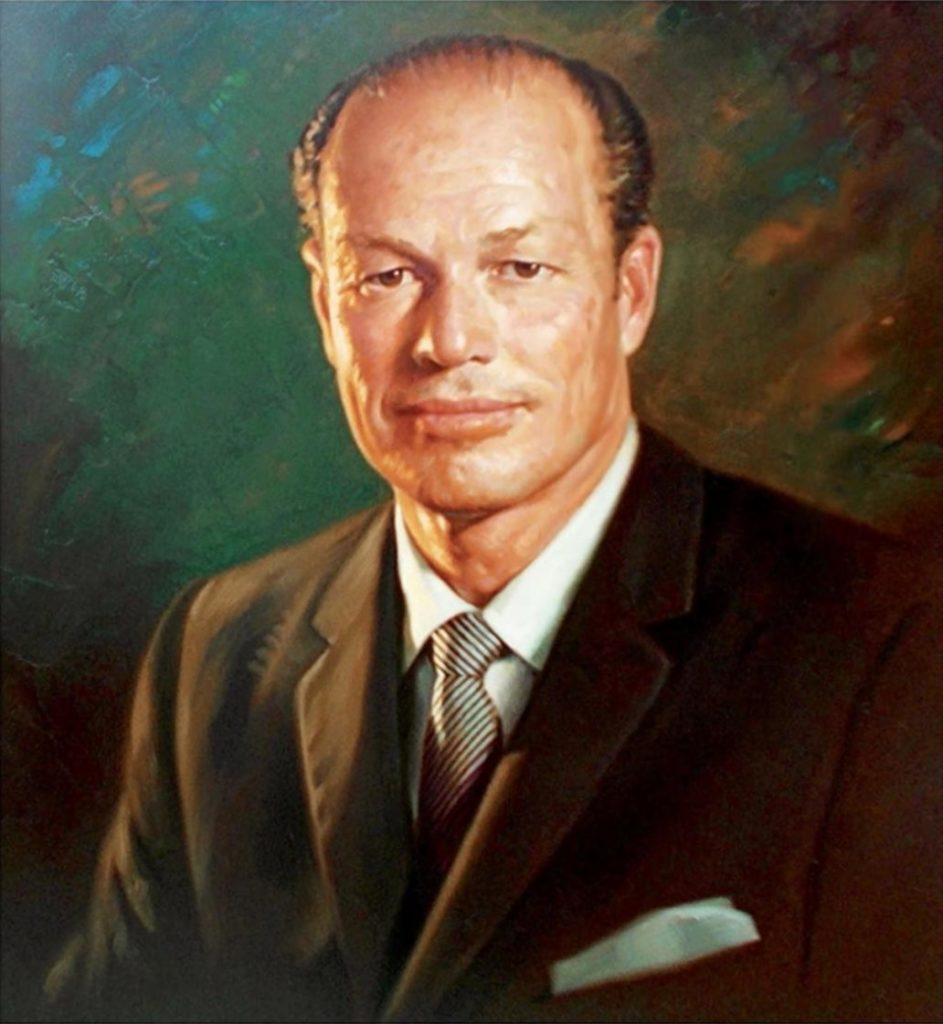
Paul Whitney Trousdale, Jr. (1914-1990). Born in Minneapolis, Minnesota, he moved to a farm outside Gallatin, Tennessee, in 1915. His father’s death when he was a child sent him shuttling among relatives in New York, Tennessee, and Los Angeles, where he graduated Los Angeles High School in 1932. During his freshman year at the University of Southern California, Trousdale sold cars, clothes and automobile spotlights. The following summer, he loaded freight elevators, receiving $5,000 in workman’s compensation for a crushed foot, which he spent on an around-the-world tour. Despite not returning to USC, Trousdale was a loyal alumnus and donor, serving on the board of trustees; USC’s University Avenue was renamed Trousdale Parkway in 1984.
In 1935, Mr. Trousdale returned from his world tour, eloped, and spent a year as an ad-man for Beech-nut chewing gum. Next, he took a $125-a-month job as a local contractor’s timekeeper, quitting to form his own contracting business with a $10,000 bank loan, the first of many.
In 1943, it was reported that Trousdale oversaw construction of Avalon Village at Avalon and Sepulveda boulevards, directly north of Wilmington (later incorporated as the city of Carson). Homes were available only to “persons engaged in plants producing war materials . . . or an employee of a branch of the United States Government engaged in war activity, or a member of any branch of the armed forces.” The houses were especially affordable under an FHA program allowing “war workers to buy homes without requiring the outlay of cash for the lot, the homes being erected on FHA leased ground, the purchaser having an option to purchase the lot at any time within 51 years.” (Homes Soon Available In Avalon Village, Long Beach Independent, May 21, 1943.)
Trousdale incorporated his Trousdale Construction Company on February 28, 1945, around the time he began working to end his Housing Construction Company partnership.
In 1946, the scale of Trousdale’s bank loans brought a visit from Bank of America head, Amadeo Giannini. At the time, Trousdale had already borrowed $30 million and was asking for an additional $50 million, which would fund the Rancho Vista development in Baldwin Hills. The two discussed lumber costs, concrete mixture, and the price of nails. The legendary banker approved the loans. (Steven M. Price,Trousdale Estates: Midcentury to Modern in Beverly Hills (Regan Arts, 2017).) Around this time, Trousdale calculated he was completing two houses per day, seven days a week, and hundreds of houses were under construction.
Time Magazine reported on Trousdale’s enterprise:
Like most builders [Trousdale] formed a new corporation for each project, dissolved it when the project was finished. Thus his fat profits were taxable at only 25% as capital gains, gave him plenty of capital to expand. In all, he invested some $900,000 in his wartime projects, made another $900,000.
Builder Upper, Time Magazine, Dec. 2, 1946.
What Time Magazine characterized as “fat profits,” and what Trousdale called “capital gains,” ended up being the focus of a tax suit culminating in a decision by the United States Court of Appeals. In 1955, the court called it a “subterfuge or sham” when the Trousdales’ 1945 tax return categorized income from the dissolution of Housing Construction Company as capital gains. (Trousdale v. Commissioner (9th Cir. 1955) 219 F.2d 563, 564.)
As the Time Magazine story was hitting newsstands, the local press was reporting that the United States government was going after Trousdale for overcharging at the 80-acre Avalon Village where Western Defense Housing Co. was the general contractor and Avalon Village Co. was the owner-operator of 500 single family and 500 double family rental units. (Veterans Here Get ‘Avalon’ Homes Priority, Pasadena Independent, Apr. 5, 1946.) Trousdale was named when the Office of Price Administration (responsible for controlling rents during World War II) alleged that he and others were gouging renters at Avalon Village:
The OPA suit asserted that the defendants used a ‘security deposit’ scheme to collect over-ceiling rent payments from tenants at the 390-unit Wilmington project. This assertedly was in the form of one month extra rent in advance. OPA said repeated pleas to stop were ignored by the accused.
OPA Charges Rent Gouging To L.A. Firms, Hollywood Citizen-News, Nov. 30, 1946.
Housing Co., owners of the project; Wilmington Management Co., a partnership managing the village; Fourth Western Defense Housing Co., and Western Defense Housing Co., both contracting and housing firms; Donald Scott, John N. Douglas, A. R. Benedict, J. D. Gingrich, Dugald A. Douglas, R. C. Smith and 10 ‘John Does,’ all variously associated with the village and with one or more of the defendant firms.
Described by the newsmagazine [Time] as a clever financier and contractor, Trousdale, victim of a fall at his home, 666 N. Saltair Ave., West Los Angeles, was unavailable for comment.
In 1947, Mr. Trousdale began attaching part of his name to his 3-bedroom, 2-bath housing developments: Westdale Village (National Blvd. & Sawtelle Blvd.; tract 14319) and Valley Westdale, (Woodman Ave. & Riverside Dr.). (Trousdale home increase on resale put at $3200 average, Daily News, Aug. 21, 1948.)
He used his entire surname on the project for which he may be best known. Trousdale Estates was his residential development on the former Doheny Ranch, which he bought in 1954. The City of Beverly Hills annexed the area in 1955 as the “Trousdale Estates Annexation.” Nearby, he built California’s first cooperative apartment building, the 22-story Beverly Towers, at 9220 Sunset Boulevard. (Paul Trousdale, Developer and Innovator, Dies, L. A. Times, Apr. 12, 1990.)
Trousdale Construction also built Los Angeles’ Baldwin Hills Crenshaw Plaza (1947) (immediately north of the company’s Rancho Vista), Las Vegas’ Sands Hotel (1952), and Inglewood’s Forum (1967). (Steven M. Price, Trousdale Estates: Midcentury to Modern in Beverly Hills (Regan Arts, 2017).)
Other Trousdale developments can be found in Palm Springs, California (Tahquitz River Estates), Burlingame, California (Mill Estates), and Oahu, Hawaii (Kaneohe Ranch).
He first became interested in the development of Kaneohe Ranch Company lands between 1946 and 1947, and in 1952 he became associated with H. K. Castle, owner and president of Kaneohe Ranch. That same year, Trousdale partnered with the Murchison brothers to develop the Mills Estate in Burlingame, California. Between 1955 and 1956, Trousdale became the president of Waikiki Development Company and partnered again with the Murchison brothers, forming Hawaiian Housing, a sales and development corporation.
Centex Trousdale, Hawai’i Modernism Library.
In 1969, Lear Siegler, Inc., a multinational corporation, acquired Trousdale Construction Co.; Mr. Trousdale remained involved in the business.
Paul Trousdale was buried at San Diego’s El Camino Memorial Park. He had built that, too.
Hyatt Robert Von Dehn
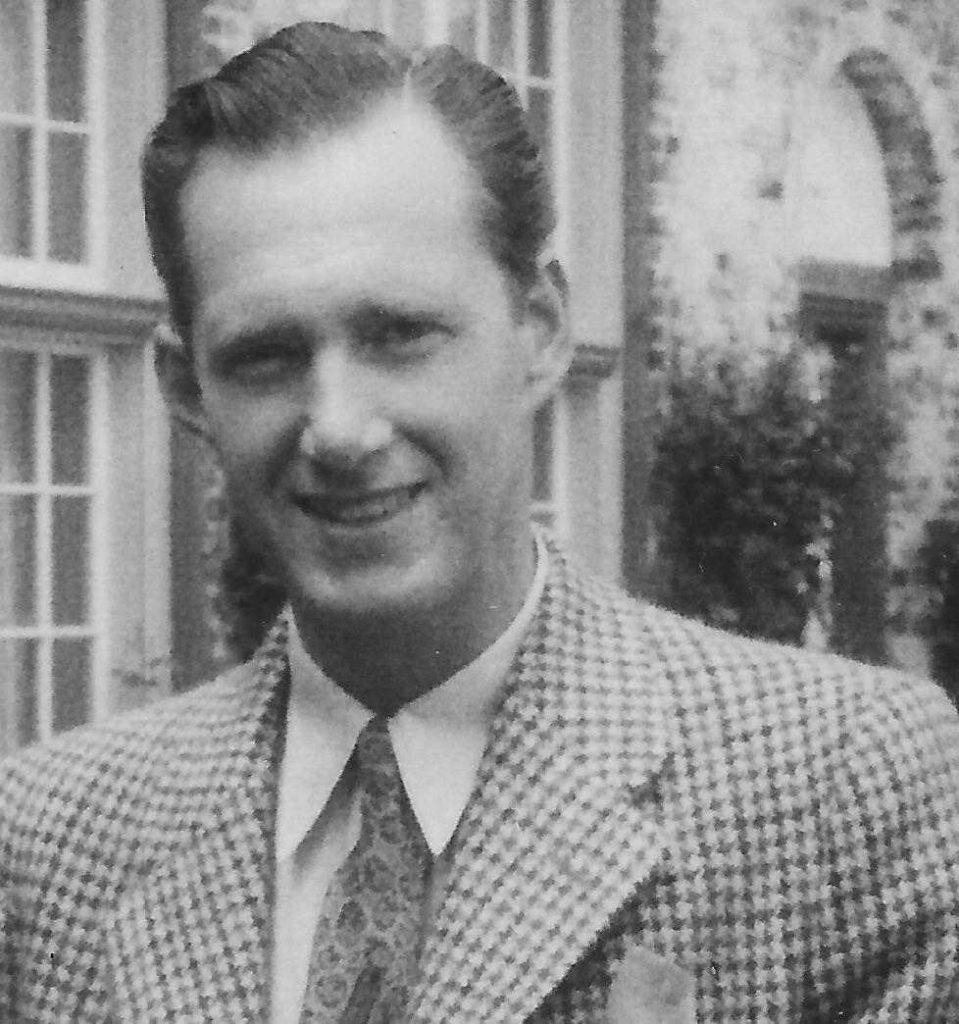
Hyatt Robert Von Dehn (1906-1973) was born in Buffalo, New York. (He would drop the “Von” and go by the less German-sounding “Dehn” during the Second World War years.) “He was a graduate engineer of Randolph-Macon College in Virginia and New York University.” (GinnySimms.com.) He “was a former assistant vice president of Manufacturers Hanover Trust Co. of New York and former president of the Cherry Valley Land and Water Co. He built 7,000 units of defense housing in Los Angeles during the war.” (VonDehn, Founded Hyatt House Chain, The Times Record, July 31, 1973.)
Von Dehn’s second marriage was to film and radio star Virginia “Ginny” Simms (1913-1994) in July 1945.
According to a Louella Parsons article in the Los Angeles Examiner of July 29, 1945, the wedding came as a great surprise to the Hollywood community. The bridegroom, 34, was a wealthy socialite from New York. . . .. By 1945, he was not only the founder, but also the executive head of the Defense Housing Corporation of Los Angeles for four years.
GinnySimms.com
Glossy life-style magazines of the 1940s described millionaire and entrepreneur Hyatt Robert Von Dehn’s residence as the consummate honeymoon home and a California Shangri-La — “a place where life can be simple and casual and not without some elegance.” (House Beautiful. June, 1946.) The home’s isolated location [original address 1432 Beverly Estates Drive, changed after 1961 to 1501 Tower Grove Road] . . . was called the perfect home for singer and movie star Ginny Simms, Von Dehn’s new bride.
Paul Revere Williams, American Architect, Gallery, Von Dehn/Simms Residence.
Maynard L. Parker (1900–1976) photographed the Dehn/Simms residence for many magazines, including Pictorial California‘s 1945 special Holiday Issue. The home was designed by Paul R. Williams (1894-1980) and decorated by Barker Brothers‘ Zann Earl. (Barker Bros. did other work for Von Dehn or Trousdale’s companies; e.g., decorating a Sepulveda Gardens model home and Avalon Village.)
Von Dehn involved Ginny Simms in his veterans’ housing development business, which aligned with her interests. Indeed, she supported those who served.
Throughout World War II and after, Ginny showed great concern for all branches of the Armed Services. Her commitment was acknowledged by President Roosevelt, and she was honored with an invitation to lunch with the Roosevelts at the White House.
Ginny Simms formed her first California committee of the “Lest We Forget” organization in June 1944. The organization would provide entertainment for hospitalized servicemen during the war and after. Her national committee included Mrs. Roosevelt, General John J. Pershing, Mayor Fiorella La Guardia of New York, Nils Trammel, President of NBC, to name a few.
GinnySimms.com
Soon after their marriage, Ginny Simms was
named vice-president and director of the Montana Corp., which [was] opening a new subdivision at Palm Springs, near the Torney General Army Hospital. The corporation was formed by Miss Simms’ husband, Hyatt Robert Dehn, founder-president of the Defense Housing Corp. Miss Simms, who often entertains at Torney General Hospital, report[ed] that the acute housing shortage at Palm Springs [was] largely due to the influx of wives of hospitalized veterans.
Ginny Simms Made Company Director, L. A. Evening Citizen-News, Nov. 2, 1945.
On December 5, 1943, the Long Beach Independent reported that, “Title to 125 homesites at the Northwest corner of Clark avenue and South street, in the Mayfair district, has been acquired from the Montana Land Co. for $66,000 by the Fourth Defense Housing company, for immediate war housing development.” (Real Estate News, Long Beach Independent, Dec. 5, 1943.) The area, in what would later be incorporated as Lakewood, was immediately east of Lakewood Gardens. In 1946, Montana Land company owned/subdivided the land for 1946’s Lakewood Gardens development, Tract 11600.
After divorcing Simms in 1951, Von Dehn married (and later divorced) actress Walda Winchell (1927-1987), daughter of famed columnist Walter Winchell (1897-1972).
Hyatt Von Dehn may be best remembered for giving his name to the Hyatt House hotel chain, which started near Los Angeles International Airport in 1954. Von Dehn had met Jack Dyer Crouch (1915-1989) at Crouch’s “Jack’s on the Strip,” a short-lived restaurant at 8801 Sunset Boulevard in West Hollywood. (By the early 1960s, that site hosted an Earl “Madman” Muntz (1914-1987) Stereo-Pak shop installing early car stereos, and by 1971 it held a Tower Records store.) Von Dehn invested in Crouch’s airport motel concept.
In 1957, entrepreneur Jay Pritzker (1922-1999) dined at the Hyatt House’s coffee shop, Fat Eddie’s, while waiting for a flight. The shop was busy and the hotel full. Seeing the potential for a chain of airport hotels to serve the growing number of business travelers, Pritzker asked to meet the owner and wrote Dehn a $2.2 million offer on a Fat Eddie’s napkin. (Jay Pritzker, Billionaire Who Founded the Hyatt Hotel Chain, Is Dead at 76, New York Times, Jan. 24, 1999.) “Von Dehn was eager to get out of the hotel business after a few years, so he sold his share in the hotel to Jay Pritzker. Jay’s younger brother Donald Pritzer, under Jack Crouch’s mentorship, took over day-to-day operations of the company and acquired motels and hotels.”
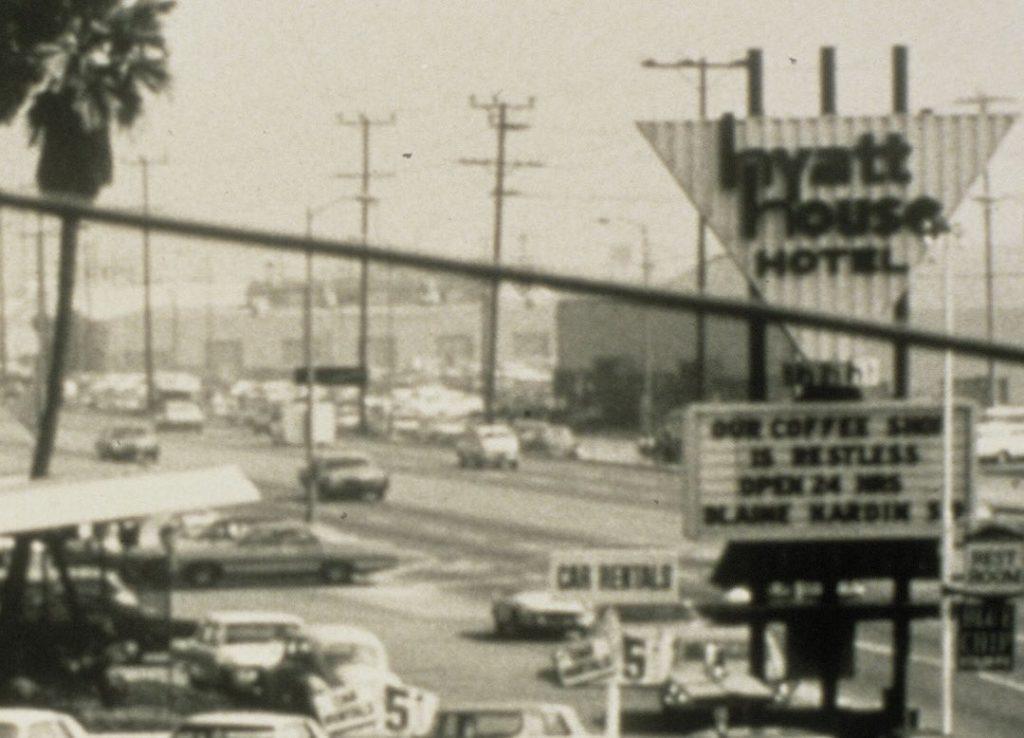
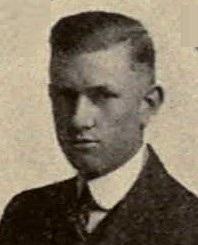
William Arthur Godshall
William Arthur Godshall (1896-1946) came to Los Angeles from Everett, Washington. He graduated for Los Angeles High School and the University of California. Godshall was well situated for supplying materials for housing construction: he was a director and vice-president of Blue Diamond Corporation, which “manufacture[d], produced and distributed cement, plaster, rock and sand, stucco, reinforcing steel, and other basic building materials throughout Southern California.” (Walker’s Manual of Pacific Coast Securities (1944), pp. 364-366.) Practically all of the company’s activities involved war-effort construction.
Mr. Godshall headed Mayfair Housing Corp., which built several hundred dwellings in Long Beach and the Harbor Heights Corp., which built in Wilmington. Mayfair Housing also built wartime housing in (today’s) Lakewood, California, area – possibly the Lakewood Gardens development – along with Trousdale and Von Dehn. In 1944, it was reported that “One hundred more lots in the South street–Lakewood boulevard district have been sold for $66,000 for single-family war housing development. The Mayfair Housing corporation was the buyer. The property was sold by the Montana Land company.” (Real Estate, Long Beach Independent, March 26, 1944.)
The Harbor Heights corporation was set to build defense housing even before the United States entered World War II. On December 1, 1941, a San Pedro, California, newspaper reported that “The Harbor Heights Corp. within 10 days will start construction of the first of 450 to 500 four-room and five-room dwellings east of the federal Harbor Hills housing development . . ..” “Building materials priorities have been promised for the dwellings, tabbed as a defense housing project . . ..” (500 Homes Slated For Harbor Hills, News-Pilot, Dec. 1, 1941.)
The paper reported that Harbor Heights’ president was “Thomas Ince.” Presumably, that was Thomas H. Ince, Jr. (1912-1970). The presumption is based on Godshall’s use of movie pioneer Thomas H. Ince’s family as straw-people in a tax dodge:
William A. Godshall, who was president of Overland [Housing Co. ], . . . interested Elizabeth Bonner [1923-1983], Eleanor K. Ince [1884-1971] and William T. Ince [1909-1972] in becoming assignees . . .. Elizabeth Bonner was Godshall’s daughter, and Eleanor K. Ince was the widow and William T. Ince the son of Thomas H. Ince [1880-1924], deceased, of whose estate Godshall was trustee.
Trousdale v. Commissioner (9th Cir. 1955) 219 F.2d 563.
Overland Housing’s 640 homes Westwood Gardens were completed before Godshall died, at 50, in October 1946. (W. A. Godshall, Builder, Dies, L. A. Times, Oct. 28, 1946.)
Mass Producing Houses
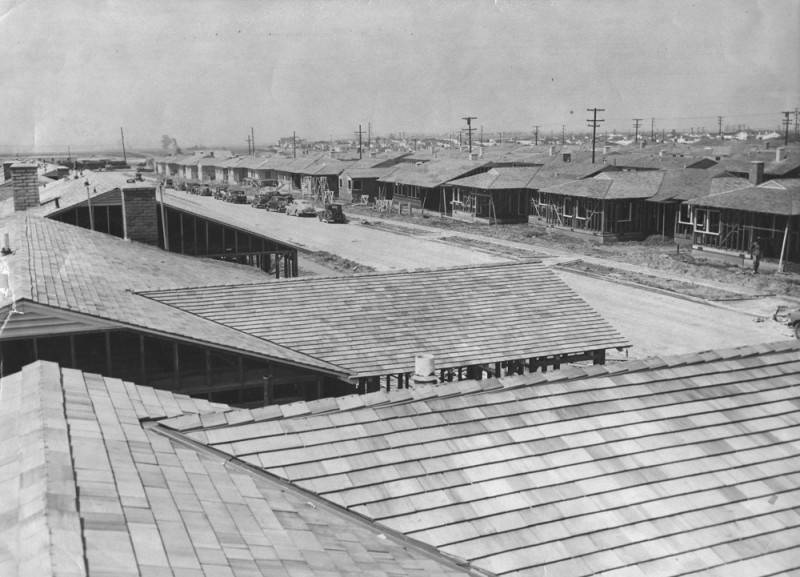
As described in Tract Housing in California, 1945-1973: A Context for National Register Evaluation, (pp. 58-60),
The key to mass-production was not moving the construction of houses to the factory, but bringing factory methods to the construction site. Fundamental to this process was the division and specialization of labor. The housing tracts put up by merchant builders were assembly lines of a sort, in which the workers moved rather than the product. Merchant builders analyzed the construction process and divided it into a series of discrete tasks that could be assigned to different work crews. Each crew would perform its assigned task repeatedly, moving from house to house, followed closely by the crew performing the next task in the sequence. Each of the following activities might be performed by a separate crew, or could be further subdivided into even more specialized tasks:
Tract Housing in California, p. 60, citing James Thomas Keane, Fritz B. Burns and the Development of Los Angeles: The Biography of a Community Developer and Philanthropist (Historical Society of Southern California, 2001), 74-75.
Site work, including grading, streets, curbs, sidewalks, and driveways
Utilities
Foundations
Subfloors or floor slabs
Wall framing and sheathing
Roof framing and sheathing
Installation of doors and windows
Exterior wall finishes
Roof shingles
Interior wall sheathing (plaster or gypsum board)
Painting
Floor finishes
Plumbing and lighting fixtures, kitchen cabinets, and appliances
Clean up
Landscaping
Of course, this sequence would be followed in the construction of any house, but in a tract of dozens or even hundreds of similar houses, staggered construction would allow different work crews to be carrying out each of these tasks simultaneously, in the same way that different sections of an auto assembly line would have cars in different stages of completion. Within a large housing tract, one crew might be pouring concrete foundations while carpenters erected walls and roof rafters on an adjacent block. On still another block, workers would be shingling roofs while painters finished the interiors. The developers of Lakewood in Los Angeles County employed 30 separate work crews, including 19 just for different carpentry tasks.
Merchant builders in California adopted these new methods somewhat in advance of the rest of the country. The partnership of Fred Marlow [1899-1997] and Fritz Burns [1899-1979] in Los Angeles may have been the first to use pre-cutting, quantity purchases, and other mass-production techniques. Their Westside Village tract [south of future Westwood Gardens], begun in 1938, included 788 houses using a single floor plan.